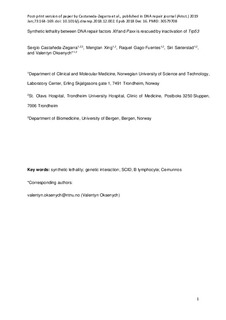| dc.contributor.author | Castañeda-Zegarra, Sergio | |
| dc.contributor.author | Xing, Mengtan | |
| dc.contributor.author | Gago-Fuentes, Raquel | |
| dc.contributor.author | Sæterstad, Siri | |
| dc.contributor.author | Oksenych, Valentyn | |
| dc.date.accessioned | 2019-02-28T11:40:21Z | |
| dc.date.available | 2019-02-28T11:40:21Z | |
| dc.date.created | 2019-01-02T10:55:09Z | |
| dc.date.issued | 2019 | |
| dc.identifier.citation | DNA Repair. 2019, 73 164-169. | nb_NO |
| dc.identifier.issn | 1568-7864 | |
| dc.identifier.uri | http://hdl.handle.net/11250/2588025 | |
| dc.description.abstract | Non-homologous end joining (NHEJ) is a DNA repair pathway that senses, processes and ligates DNA double-strand breaks (DSBs) throughout the cell cycle. During NHEJ, core Ku70 and Ku80 subunits bind DSBs as a heterodimer and promote further recruitment of accessory factors (e.g., PAXX, Mri, DNA-PKcs, Artemis) and downstream core subunits XRCC4 and DNA ligase 4 (Lig4). Inactivation of Ku70 or Ku80 genes in mice results in immunodeficiency and high levels of genomic instability; deletion of individual Dna-pkcs, Xlf, Paxx or Mri genes results in viable mice with no or modest DNA repair defects. However, combined inactivation of either Xlf and Dna-pkcs, or Xlf and Paxx, or Xlf and Mri, leads to synthetic lethality in mice, which correlates with increased levels of apoptosis in the central nervous system. Here, we demonstrated that inactivation of pro-apoptotic factor Trp53 rescues embryonic lethality of Xlf−/−Paxx−/− and Xlf−/−Dna-pkcs−/− double knockout mice. Moreover, combined inactivation of Paxx and Dna-pkcs results in live-born fertile Paxx−/−Dna-pkcs−/− mice indistinguishable from Dna-pkcs−/− knockout controls. | nb_NO |
| dc.language.iso | eng | nb_NO |
| dc.publisher | Elsevier | nb_NO |
| dc.rights | Attribution-NonCommercial-NoDerivatives 4.0 Internasjonal | * |
| dc.rights.uri | http://creativecommons.org/licenses/by-nc-nd/4.0/deed.no | * |
| dc.title | Synthetic lethality between DNA repair factors Xlf and Paxx is rescued by inactivation of Trp53 | nb_NO |
| dc.type | Journal article | nb_NO |
| dc.type | Peer reviewed | nb_NO |
| dc.description.version | acceptedVersion | nb_NO |
| dc.source.pagenumber | 164-169 | nb_NO |
| dc.source.volume | 73 | nb_NO |
| dc.source.journal | DNA Repair | nb_NO |
| dc.identifier.doi | 10.1016/j.dnarep.2018.12.002 | |
| dc.identifier.cristin | 1648334 | |
| dc.description.localcode | © 2018. This is the authors’ accepted and refereed manuscript to the article. Locked until 16.12.2020 due to copyright restrictions. This manuscript version is made available under the CC-BY-NC-ND 4.0 license http://creativecommons.org/licenses/by-nc-nd/4.0/ | nb_NO |
| cristin.unitcode | 194,65,15,0 | |
| cristin.unitname | Institutt for klinisk og molekylær medisin | |
| cristin.ispublished | true | |
| cristin.fulltext | original | |
| cristin.qualitycode | 1 | |

